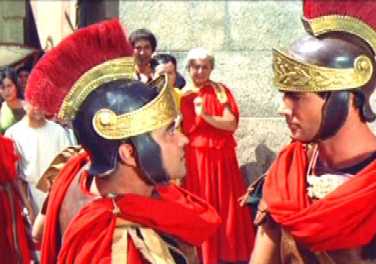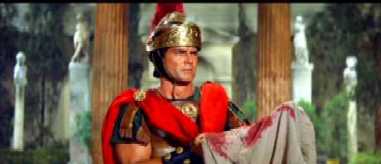THE LAST DAYS OF POMPEII isn't on any list of Naschy films I have seen -- it doesn't help that Naschy's autobiography eliminates all of his pre-starring appearances from his official filmography -- but it was mostly shot in Madrid and at a time when Molina was known to be making screen appearances. In the scene in question, the centurion Glaucus (Reeves) returns to Pompeii after victory in battle and stops to intercede in a Roman guard's flogging of a helpless villager. Glaucus grabs the sadistic guard by the wrist and then you see this:


My apologies for the lousy image compression, but this is as large as I can make the frame without knocking all the information to the right to the bottom of this screen. Yesterday I sent these grabs to various friends, including Naschy authority Mirek Lipinski of Latarnia International, for verification. Mirek agrees there is a resemblance, but otherwise doubts it could be Naschy, as he feels El Hombre Lobo would have spoken before now of having acted opposite someone as iconic and as personally inspirational to him, as an athlete, as Reeves. (PS: Yes, that's Angel Aranda of PLANET OF THE VAMPIRES to the side of Reeves in the second shot.)
You know, having just published these grabs and seen how poorly they communicate what I am talking about, I'm going to blow them up and crop them a bit so you can better see what I saw:


Better, yes? The first one really looks like him, I think... but it's probably not Paul Naschy, so please don't go spreading this rumor all over the Internet; I just wanted to share my surprise with you, and the possibility, shall we say, because I got a bigger kick out of this little eureka than I did from almost everything else this rather turgid epic had to offer.
This DVD was my first opportunity to see THE LAST DAYS OF POMPEII in its correct anamorphic widescreen ratio, and I was disappointed to find that it doesn't hold up very well. The script -- written by a half-dozen old hands at Italian pepla including Ennio De Concini, Sergio Leone, Duccio Tessari and Sergio Corbucci -- plays less like an adaptation of Edward Bulwer-Lytton's novel than a "greatest clichés of the sword-and-sandal genre." The romantic leads meet when Reeves rescues Kaufmann from a runaway chariot; hooded men in the secret employ of Pompeii's High Priest (Fernando Rey) are murdering innocent people and leaving evidence behind to implicate Christians; henchmen deprived of their due are led to a pile of riches that turns out to be fatally booby-trapped; Reeves is chained in a dungeon and tears his way free just in time to save the day -- it's all very familiar. This could have been any other peplum script with an erupting volcano tagged onto the end. The climactic cataclysm is an immense disappointment too, consisting of lots of extras running around under a shower of fireworks sparklers, intercut with stock footage of Vesuvius and optical overlays of fireworks, and only one shot of lava -- which looks more like raw sewage as it feebly engulfs a fleeing man's dropped riches. I hope you know by now that I am not one of those critics who looks down his nose at all movies of this kind; I love a good many of them, from the best to the cheesiest, but this one fails in pretty much every department.
The film's direction is credited to Mario Bonnard, but the aging filmmaker fell ill shortly after production began and he was replaced by his assistant Sergio Leone. (Hence, Leone's "Meisterwerk.") Leone had his own difficulties on the sets in Madrid (he and Reeves didn't get along), and Sergio Corbucci was drafted to direct second-unit scenes at Cinecittà. It was the first of the sandaloni to be produced as a truly epic international co-production, with talent and monies pooled not only from Italy and America, but also from Germany, France, and Monaco; this diversity seems to have been more hindrance than help. Reeves and Kaufmann, speaking English and German at one another, never seem to connect, and the film's villainess, the voluptuous but otherwise boring Barbara Carroll, appears to have been cast solely for her ability to fill Anita Ekberg's old wardrobe from SIGN OF THE GLADIATOR. By far the most expensive peplum produced up to its time, THE LAST DAYS OF POMPEII looks like one of the cheapest -- and the special effects men may have agreed because neither of them worked under their real names. “Magasoli” likely refers to one of two Spanish cinematographers active at the time (Augustín or Antonio Macasoli), while “Erasmo Bacciucchi” was surely the pyrotechnician Eros Bacciucchi. Speaking of which, the screen credits of this film are a veritable madhouse of misinformation -- Sergio Leone himself is credited with directing the second unit!
Laser Paradise's DVD is a deluxe two-disc item that pairs the 1959 film with the 1913 silent version from Italy, directed by Mario Caserini. (Do not confuse the German import with this domestic release, a pan&scan atrocity which also includes the 1913 film as a bonus.) The 1959 version is presented in its original aspect ratio and is generally fine, allowing for some individual scratchy or flecky shots that turn up in otherwise spotless sequences. The color is bold without being overdone. Three different soundtracks are offered in both German or English: original mono, DD 5.1, and DTS 5.1. The latter two principally pack more dimensional, re-recorded sound effects, with some outright fireworks sounds during the scenes of destruction that inadvertently make them more comic. The 5.1 mixes also have a tendency to drown out dialogue and, to an even greater extent, the Angelo Francesco Lavagnino score. The original mono mixes are recommended. The bonus feature (alas, without English intertitles) looks good and is effectively tinted; the red-tinted disaster scenes (likely the uncredited work of Mario Bava's father, Eugenio) seem light years ahead of the remake's capabilities. Cast and crew bios, information about Mt. Vesuvius, and a photo gallery are also included, as are some unrelated promotional trailers.
THE LAST DAYS OF POMPEII (or DIE LETZEN TAGE VON POMPEJI, as the cover art reads) is available here.
Postscript: To the best of my knowledge, this piece marks the English-language debut of the plural term "sandaloni." I found this interesting generic term in an Italian interview with screenwriter Ennio De Concini, published in a history of the Italian production company Galatea. I find this synonym less cumbersome than "sword-and-sandal" and more manly than "peplum," the more compact term assigned to this genre by the French, and I naturally bow to its Italian provenance.
